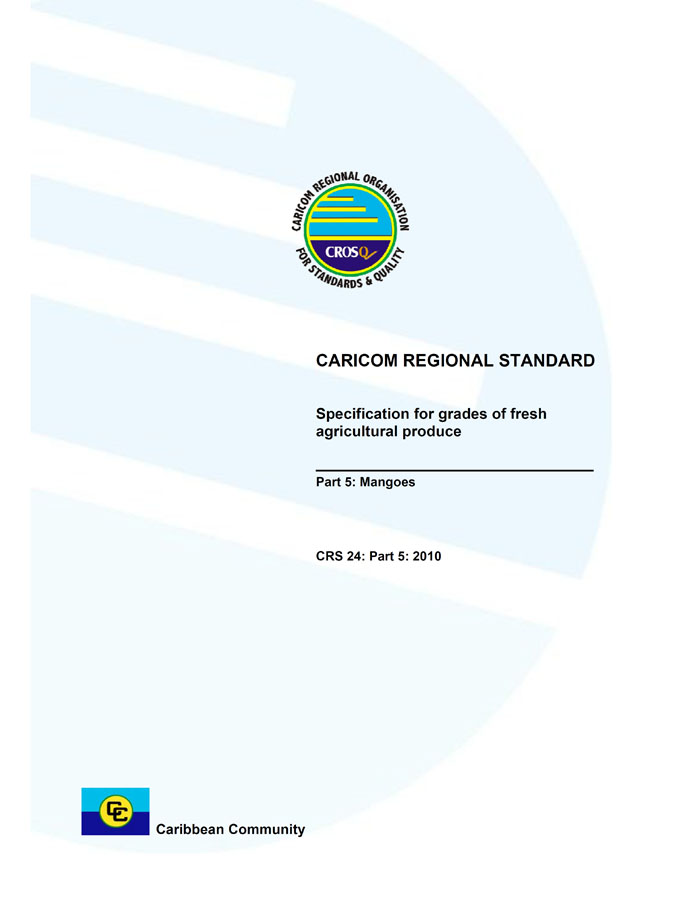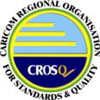
In order to promote public education and public safety, equal justice for all, a better informed citizenry, the rule of law, world trade and world peace, this legal document is hereby made available on a noncommercial basis, as it is the right of all humans to know and speak the laws that govern them.


CARICOM Regional Organisation for Standards and Quality (CROSQ)
2nd Floor Nicholas House
29 & 30 Broad Street
Bridgetown, St Michael
Barbados
T: 246.622.7670 | F: 246.622.7678
Website: http://www.crosq.org
© CROSQ 2010 – All rights reserved
Unless otherwise specified, no part of this publication may be reproduced or utilized in any form or by any means, electronic or mechanical, including photocopying and microfilm, without permission.
CRS 24: Part 5: 2010
CARICOM Regional Organisation for Standards and Quality (CROSQ)
2nd Floor, Nicholas House
29 & 30 Broad Street
Bridgetown, St. Michael
Barbados
T: 246.622.7670 | F: 246.622.7678
Website: http://www.crosq.org
© CROSQ 2010 – All rights reserved. No part of this publication is to be reproduced without the prior written consent of CROSQ.
ISBN 978-976-8234-07-0
ICS 67.080
| AMENDMENT NO. | DATE OF ISSUE | TYPE OF AMENDMENT | NO. OF TEXT AFFECTED | TEXT OF AMENDMENT |
|---|---|---|---|---|
This CARICOM Regional Standard was prepared under the supervision of the Regional Technical Committee for Agricultural Commodities (RTC 19), (hosted by the CARICOM Member State, Dominica), which at the time comprised the following members:
| Members | Representing |
|---|---|
| Mr. Lloyd Pascal (Chairperson) | Dominica Export Import Agency (DEXIA) |
| Mr. Ricky Allport | Division of Agriculture, Dominica |
| Mr. Ryan Anselm | Plant protection and Quarantine Services, Dominica |
| Mr. Peter Dominique | Parry W. Bellot & Co. Ltd |
| Mr. Clement Ferreira | Nature’s Best, Dominica |
| Mr. Cecil Joseph | Dominica Hucksters Association (1995) Ltd. (DHA) |
| Mr. Rawle Leslie | Dominica State College – Agriculture Faculty |
| Mr. Angus Mclntyre | Windward Island Banana Development Cooperation (WIBDECO) |
| Dr. Gregory Robin, PhD | Caribbean Research and Development Institute (CARDI) |
| Mr. Kevin Stephenson | Inter-American Institute for Cooperation on Agriculture (IICA) |
| Mr. Delroy Williams | National Association of Youth in Agriculture (NAYA) |
| Dr. Nadia Pacquette – Anselm (Technical Secretary) | Dominica Bureau of Standards |
| Foreword | 1 | |||
| 1 | Scope | 2 | ||
| 2 | Normative references | 2 | ||
| 3 | Terms and definitions | 2 | ||
| 4 | Requirements | 3 | ||
| 4.1 | Quality | 3 | ||
| 4.1.1 | Minimum requirements | 3 | ||
| 4.1.2 | Classifications | 4 | ||
| 4.2 | Tolerances | 5 | ||
| 4.2.1 | Quality tolerances | 5 | ||
| 4.3 | Size | 5 | ||
| 5 | Presentation | 5 | ||
| 5.1 | Uniformity | 5 | ||
| 5.2 | Packaging | 5 | ||
| 5.3 | Labelling | 6 | ||
| 6 | Contaminants | 6 | ||
| 6.1 | Heavy metals | 6 | ||
| 6.2 | Pesticide residues | 7 | ||
| 7 | Hygiene and sanitation | 7 | ||
This CARICOM Regional Standard was developed in an effort to:
This standard was approved by the Twenty-ninth Council for Trade and Economic Development (COTED) on 8-9 February 2010.
In the development of this standard, assistance was derived from the following:
NOTE During the development of this standard, the CARICOM Regional Code of Practice for Food Hygiene was still under development.
1This Standard specifies the quality requirements for commercial varieties of mangoes grown from Mangifera indica L., of the Anacardiaceae family, to be supplied fresh to the consumer after preparation and packaging.
This standard does not apply to mangoes for industrial processing.
The following referenced documents are indispensable for the application of this document. For dated references, only the edition cited applies. For undated references, the latest edition of the referenced document (including any amendments) applies.
CARICOM Regional Code of Practice for Food Hygiene
CODEX Alimentarius Commission, CAC/RCP 44, Code of Practice for packaging and transport of tropical fresh fruits and vegetables
For the purposes of this standard the following terms and definitions shall apply.
any physical injury affecting the surface of the fruit, such as scars or scratches, which detracts from its natural appearance, but will not significantly affect its shelf life
free from loose or adhering soil and all foreign matter
defect or combination of defects which materially detract from the appearance or edible quality of the fruit such as bruises, cuts, insect damage, or damage caused by physiological disorder
not soft or noticeably wilted and skin not swollen
free from any visible evidence of moulds, fungal and bacterial rots, spots or any symptoms of viral infection
no signs of insects at any stage of development present on or in the fruit or in the package
two or more mangoes whether or not packaged, but sold as one distinct and separate group
2stage of development where optimum growth characteristics of the variety are attained that will ensure the proper completion of the ripening process
stalk is intact and not more than 6 mm (1/4 inch) long
flesh, skin and flesh colour, odour, shape and size typical of the variety
produce not affected by rotting or deterioration which makes it unfit for consumption
shape is characteristic of the variety and is symmetrical without irregularities in shape
Mangoes shall meet or exceed the following minimum requirements subject to the special provisions of 4.1.2 and 4.2:
Mangoes shall be sufficiently developed, displaying satisfactory ripeness.
Mangoes shall be carefully picked at the stage of physiological development so as to enable them to:
NOTE In relation to the evolution of maturing, the colour may vary according to variety.
Mangoes shall be classified as Classes I, II and III.
Mangoes in this class shall meet the following requirements:
Mangoes in this class shall meet the following requirements:
NOTE Scattered rusty lenticels and a yellowing of green varieties (due to exposure to direct sunlight, not exceeding 40 % of the surface of the fruit, excluding necrotic stains) are also allowed.
Mangoes in this class satisfy the minimum requirements specified in 4.1.1. The following defects may be allowed provided the mangoes retain their essential characteristics with regards to the quality, the keeping quality and presentation:
NOTE Scattered rusty lenticels and a yellowing of green varieties (due to exposure to direct sunlight, not exceeding 40 % of the surface of the fruit, excluding necrotic stains) are also allowed.
Each class shall be allowed a degree of tolerance with respect to quality and size in each package for mangoes not satisfying the requirements of the class indicated.
5 % by number or weight of mangoes not satisfying the requirements of this class but meeting those of Class II or, exceptionally, coming within the tolerances of that class.
10 % by number or weight of mangoes not satisfying the requirements of this class but meeting those of Class III or, exceptionally, coming within the tolerances of that class.
10 % by number or weight of mangoes satisfying neither the requirements of this class nor the minimum requirements, with the exception of fruit affected by rotting, marked bruising or any other deterioration rendering it unfit for human consumption.
Size is determined by the market requirements and should be specific to the variety.
The contents of each package shall be uniform and contain only mangoes of the same origin, variety, quality and size.
The visible part of the contents of the package shall be representative of the entire contents.
Mangoes shall be packed in such a way as to adequately protect the produce.
5The materials used inside the package shall be new, clean and of a quality such as to avoid causing any external or internal damage to the produce.
NOTE 1 For the purposes of this standard, new material includes recycled material of food-grade quality.
NOTE 2 The use of materials and particularly paper or stamps bearing trade specifications is allowed provided the printing or labelling has been done with non-toxic ink or glue.
Packages shall be free of all foreign matter.
Mangoes shall be packed in each container in compliance with the latest edition of CAC/RCP 44, Code of Practice for packaging and transport of tropical fresh fruits and vegetables.
Each package of mangoes shall bear the following particulars, in letters grouped on the same side, legibly and indelibly marked, and visible from the outside:
NOTE District where grown or national, regional or local place name is optional.
NOTE 1 Size code for commercial specifications is optional.
NOTE 2 Official control mark is optional.
NOTE 3 The use of red or orange should be avoided since these colours are used in the labelling of dangerous goods.
Mangoes shall comply with those maximum levels for heavy metals established by the CODEX Alimentarius Commission for this commodity.
6Mangoes shall comply with those maximum residue limits established by the CODEX Alimentarius Commission for this commodity.
It is recommended that the produce covered by the provisions of this standard be prepared and handled in conjunction with the appropriate clauses of the latest edition of the CARICOM Regional Code of Practice for Food Hygiene or other international Codes of Practice which are relevant to this commodity.
In keeping with good manufacturing practice, the product shall be free from objectionable matter.
When tested by approved methods of sampling and examination, the product shall:
Mangoes shall comply with Sanitary and Phyto-sanitary requirements of both the importing and exporting countries.
7
The CARICOM Regional Organisation for Standards and Quality (CROSQ) was created as an Inter-Governmental Organisation by the signing of an agreement among fourteen Member States of the Caribbean Community (CARICOM). CROSQ is the regional centre for promoting efficiency and competitive production in goods and services, through the process of standardization and the verification of quality. It is the successor to the Caribbean Common Market Standards Council (CCMSC), and supports the CARICOM mandate in the expansion of intra-regional and extra-regional trade in goods and services.
CROSQ is mandated to represent the interest of the region in international and hemispheric standards work, to promote the harmonization of metrology systems and standards, and to increase the pace of development of regional standards for the sustainable production of goods and services in the CARICOM Single Market and Economy (CSME), and the enhancement of social and economic development.
CROSQ VISION:
The premier CARICOM organisation for the development and promotion of an Internationally Recognised Regional Quality Infrastructure; and for international and regional harmonized CARICOM Metrology, Standards, Inspection, Testing and Quality Infrastructure
CROSQ MISSION:
The promotion and development of standards and standards related activities to facilitate international competitiveness and the sustainable production of goods and services within the CARICOM Single Market and Economy (CSME) for the enhancement of social and economic development
8 9